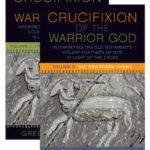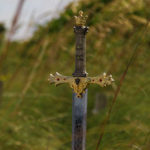We run our website the way we wished the whole internet worked: we provide high quality original content with no ads. We are funded solely by your direct support. Please consider supporting this project.

Was the Early Church Pacifistic? A Response to Paul Copan (#11)
In Crucifixion of the Warrior God (CWG) I argue that Jesus and Paul instruct Christians to love and bless their enemies and to unconditionally refrain from violence (e.g. Matt 5:39-45; Rom 12:14-21). Moreover, I argue that this was the prevailing attitude of Christians prior to the fourth century when the Church aligned itself with the Roman Empire. In his critique of CWG that he delivered at the ETS in November, Copan argues against this, contending that I give “the false impression that Christians were uniformly pacifistic until Constantine.” He cites the work of David Hunter and several other scholars who note that we find a number of references to Christians serving in the Roman military in the writings of Tertullian, Lactantius, Clement of Alexandra and Eusebius. [1] Not only this, but we have found a number of tomb inscriptions to Christian soldiers in the second and third centuries. On this basis, these scholars argue that the earlier scholarly consensus that the early church was uniformly pacifistic must be nuanced. At least some Christians were apparently not opposed to Christians serving in the military.
The first thing I’ll say is that it is a bit odd that Copan would raise this objection against me, for while I defend “the predominant nonviolence of the early church” prior to “the Augustinian revolution,” I also explicitly note that the earlier unqualified depictions of the early church as uniformly against military service “were not sufficiently nuanced” ((CWG, 24, n.45). Indeed, I refer readers to some of the same works that Copan cites against me (and add a number that he omits).
Second, and more importantly, while I grant that the earlier consensus needs to be more nuanced, I would argue that Copan and some other scholars who emphasize the evidence of early Christians serving in the military could be charged with giving the false impression that the early church was not predominantly, if not uniformly, opposed to military service and all forms of violence. The question is, how significant is the evidence of early Christians serving in the military? In my estimation, not much. Three considerations put this evidence in a proper perspective.
First, in The Apostolic Tradition (c.200), Hippolytus addresses the issue of Christians serving in the military. He disallows Christians to enlist in the military, claiming that any Christian who did this “despises God” (Apostolic Tradition, 16). At the same time, Hippolytus allows soldiers who converted after joining the military to remain in it, but only if these soldiers are able to serve in a capacity that didn’t require them to kill and that didn’t require them to engage in idolatry (since the Roman religion permeated the military). While we of course can’t assume that the views of Hippolytus were shared by everyone at the time, it certain calls into question the assumption that the evidence of Christians serving in the military indicates that some early Christians were not committed to pacifism.
Second, it is highly significant that, while certain authors mention Christians serving in the military, no early Christian author defends Christians serving in the military or engaging in any other kind of violence. To the contrary, whenever early Christians mention war or other kinds of violence, it is to emphasize that Christians are to have nothing to do with it. For example, Tertullian addresses the issue of Christians serving in the military when he writes:
How will a Christian man participate in war? It is true that soldiers came to John [the Baptist] and received the instructions for conduct. It is true also that a centurion believed. Nevertheless, the Lord afterward, in disarming Peter, disarmed every solider. Ante-Nicene Fathers (ANF, III. 73)
And again,
Is it lawful to make an occupation of the sword, when the Lord proclaims that he who uses the sword will perish by the sword? Will the son of peace take part in the battle when it does not become him even to sue at law? Will he who is not the avenger even of his own wrongs, apply the chain, the prison, the torture, and the punishment. (ANF III.100)
Third, Tertullian clearly believed he was expressing the conviction of all Christians in his day when he wrote, and all indications are that he was correct. To demonstrate this, I offer the following (far from exhaustive) sampling of quotes of early church thinkers that reflect the early Christian view of war and violence.
- “We who formerly murdered one another now refrain from making war even upon our enemies.” Justin Martyr, Ante-Nicene Fathers (ANF) I.176
- “We used to be filled with war…now all of us [Christians] have, throughout the whole earth, changed our warlike weapons. We have changed our swords into plowshares, and our spears into farming implements.” Justin Martyr, ANF I.254
- “We have learned not to return blow for blow, nor to go to law with those who plunder or rob us. Instead, even to those who strike us on the side of the face, we offer the other side also.” Athenagoras, ANF II.129
- “[Christians] formed their swords and war-lances into plowshares…that is, into instruments used for peaceful purposes. So now, they are unaccustomed to fighting. When they are struck, they offer also the other cheek.” Irenaeus, ANF I. 512
- “It is not in war, but in peace, that we have been trained.” Clement of Alexandria, ANF II. 234
- “An enemy must be aided, so that he may not continue as an enemy. For by help, good feeling is compacted and enmity dissolved.” Clement of Alexandra, ANF II. 370
- “If, then, we are commanded to love our enemies…whom have we to hate? If injured, we are forbidden to retaliate, lest we become just as bad ourselves. Who can suffer injury at our hands?” Tertullian, ANF III.45.
- “How often you [legal authorities] inflict gross cruelties on Christians….Yet, banded together as we are, ever so ready to sacrifice our lives, what single case of revenge for injury are you able to point to?” Tertullian ANF III. 45
- “We willingly yield ourselves to the sword. So what wars would we not be both fit and eager to participate in…if in our religion it were not counted better to be slain than to slay?” Tertullian ANF III. 45
- “The Christian does no harm even to his enemy.” Tertullian, ANF III. 51
- “God put His prohibition on every sort of man-killing by that one inclusive commandment, ‘You shall not kill.’” Tertullian ANF III. 80
- “Christ nowhere teaches that it is right for His own disciples to offer violence to anyone, no matter how wicked. For He did not consider it to be in accord with His laws to allow the killing of any individual whomever…For [Christian] laws do not allow them on any occasion to resist their persecutors, even when it was their fate to be slain as sheep.” Origen, ANF IV.467
- “We have cut down our hostile, insolent, and wearisome swords into plowshares. We have converted into pruning hooks the spears that were formerly used in war. For we no longer take up ‘sword against nation,’ nor do we ‘learn war anymore.’ That is because we have become children of peace for the sake of Jesus, who is our Leader.” Origen, ANF IV. 558
- “Our prayers defeat all demons who stir up war….in this way, we are much more helpful to the kings than those who go into the field to fight for them….So none fight better for the king than we do. Indeed, we do not fight under him even if he demands it. Yet, we fight on his behalf, forming a special army-an army of godliness- by offering our prayers to God.” Origen ANF IV.667.
- “Wars are scattered all over the earth with the bloody horror of camps. The whole world is wet with mutual blood. And murder- which is admitted to be a crime in the case of an individual—is called a virtue when it is committed wholescale.” Cyprian, ANF V.277
- “The hand must not be spotted with the sword and blood-not after the Eucharist is carried in it.” Cyprian, ANF V. 488
- “…it is better to suffer wrong than to inflict it. We would rather shed our own blood than stain our hands and our conscience with that of another.” Ambrose, ANF VI .415
- “[The Christian] considers it unlawful not only to commit slaughter himself, but to be present with those who do it.” Lactantius, ANF VII. 169
- “How can a man be just who hates, who despoils, who puts to death? Yet, those who strive to be serviceable to their country do all these things.” Lactantius, ANF VII. 169
I trust this sampling of quotes suffices to demonstrate that the pre-Constantinian church was indeed pacifistic, notwithstanding the fact that it permitted soldiers to remain in military service after they converted. And it was this strong stance against violence that motivated many early Christian thinkers to explore non-violent interpretations of the OT’s violent depictions of God. I wrote CWG (and Cross Vision) because I believe it is time for the church to reembrace the pacifism of the early church and to take up the challenge of finding the non-violent God revealed in Christ in the OT’s warrior portraits of God.
[1] David G. Hunter, “A Decade of Research on Early Christians and Military Service,” Religious Studies Review 18, n.2 (1989); Roland Bainton, Christian Attitudes Toward War and Peace (Abington, 1960).
Photo by Nathan Fertig on Unsplash
Category: General
Tags: Crucifixion of the Warrior God, Cruciform Theology, Non-Violence, Pacifism, Paul Copan
Topics: Enemy-Loving Non-Violence
Related Reading

Overemphasizing Christ?
In response to my work, some have argued that I tend to overemphasize Christ. In light of the claim that in Jesus we have the one and only definitive Word of God and that no previous revelation should ever be placed alongside him or allowed to qualify what he reveals about God, some allege that…

How Are We To Love the Soldiers of ISIS?
Over the last several weeks I’ve received some form of this question almost every day. In some cases the question is asked rhetorically, as though the very question exposes the absurdity of suggesting we are to love this terroristic group. Other times the question is asked with a pragmatic twist. One person recently said to…

Crucifixion of the Warrior God Update
Did you know that authors generally don’t have much say-so about the cover art for their books? It’s considered part of the marketing, so the author may or may not like how it ends up looking. I’ve had a few book covers that made me scratch my head. (I won’t tell you which ones, but it would…

The Forgotten Heart of King’s Dream
Every year Shelley and I attend the annual Dr. Martin Luther King Jr. Breakfast with some friends. As you might have expected, there was an excitement in the room this year that was unlike anything we’ve witnessed in the past. Tomorrow we will witness what is undoubtedly the most remarkable achievement of King’s dream as…

Podcast: Why Did Jesus Say He Came to Bring a Sword?
Greg considers what Jesus meant when he said he had come to bring a sword. http://traffic.libsyn.com/askgregboyd/Episode_0312.mp3

Why Greg Can’t be Accused of Marcionism (Let’s Not Burn Him at the Stake Just Yet)
Kristin Brenemen via Compfight Richard Beck posted a blog today entitled It’s the Same God: On Marcionism, Creeds, Hermeneutics and War. You’re going to want to take the time to read through it in its entirety. Greg has been accused of Marcionism quite a lot as a result of the working out of his Cruciform…
